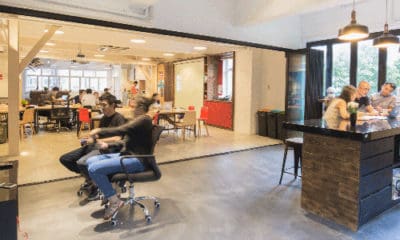
Campfire kicked off with its Kennedy Town location in 2016
Plans by Hong Kong shared space provider Campfire to add a combined, kindergarten, shared office and food centre in the Whampoa section of Kowloon city to its existing set of five co-working centres on Hong Kong island were revealed in an announcement on Thursday by property consultancy Colliers International.
The 80,000 square foot (7,432 square metre) collaborative space will be housed in a three-floor retail podium of the Harbourfront Landmark residential complex, which was acquired by a Pamfleet real estate fund in June for HK$1.1 billion. With Colliers having arranged for Campfire to become the sole tenant of the once-vacant property, Pamfleet has filled its Kowloon harbourfront acquisition within two months of acquisition.
Around two years after starting off with an 8,000 square foot location in Kennedy Town at the west end of Hong Kong Island, Campfire announced in July that it had raised $18 million in fresh funding to help expand its network into markets including London, Melbourne, Sydney, and Singapore. The Whampoa project will be the collaborative space operator’s first venture beyond flexible offices into shared retail and education space.
Co-Learning Space in a Collaborative Center
The new site for Campfire is located in at 11 Wan Hoi Street in Kowloon’s Hung Hom district, in the commercial podium of the Harbourfront Landmark residential complex building. The commercial podium acquired by Pamfleet occupies the lower three floors of the 2002-vintage complex, and in the past primarily housed retailers servicing the residents of the 59, 57, and 55-storey condo blocks that tower over the commercial space. Campfire’s new site fronts Victoria Harbor and is a five-minute walk from the Whampoa MTR station on the Kwun Tong line.
Pamfleet is not able to reveal the rental for the three-layer podium, Colliers representatives out that retail property in the area is now trading at around HK$30 to HK$35 per square foot per month.

Pamfleet acquired the podium of the Harbourfront Landmark complex in June
According to the press release, the collaborative working center will house some flexible educational facilities to fit the needs of the Kowloon neighbourhood, including a kindergarten, in addition to the co-working space. Jonathan Wright, the director of Colliers’ Flexible Workspace Services in Asia Pacific told Mingtiandi that the development of the collaborative space is designed to fit the needs of the neighbourhood. “There is a high density of residential accommodation in the area so we feel that educational use in the area should thrive,” said Wright.
The Whampoa project, which is scheduled to open later this year, will be located on the third, fifth, and sixth floors of the building, while the building doesn’t have a fourth floor. According to Allan Lee, managing director of Pamfleet, the three floors are allocated respectively to kindergarten, co-working space, and a co-retail space including restaurants and café shops.
Pamfleet Sold Office Building After Leasing to Naked Hub

Pamfleet managing director Allan Lee is learning to love flexible space
Campfire’s Whampoa project marks the second time that Colliers helped Pamfleet to find a shared economy tenant for one of its newly acquired properties, according to sources with the redevelopment specialist.
After one of its funds acquired what was then still called the EIB Centre in Sheung Wan in 2016 for HK$ 1 billion, Colliers assisted Pamfleet in leasing 16 floors of the 29-storey project — around 48,550 square feet of GFA — to co-working operator naked Hub. The property fund manager subsequently resold the building on behalf of the fund — at an HK$700 million profit — for HK$1.7 billion in January of this year.
Campfire Raised $18 Million in July
Campfire’s Whampoa site was the co-working space provider’s first major new lease after it raised $18 million in a Series A investment led by Kwai Hung Group, Sa Sa Int’l Holdings and Fast Global Holdings which was announced on July 24th. Other major investors also include Ring Capital Ltd and Potent Assets Ltd.
To distinguish from the increasingly crowded co-working industry, the two-year-old collaborative space operator developed a new approach to shared real estate integrating the co-living, co-learning, and co-retail together into lifestyle hubs.
Leave a Reply